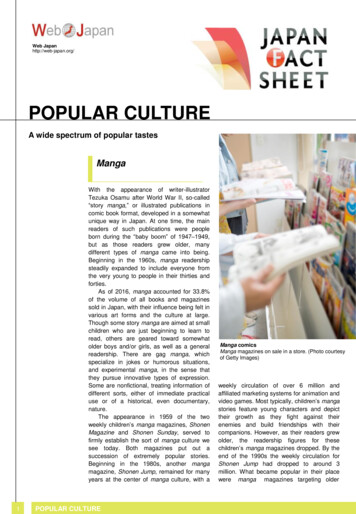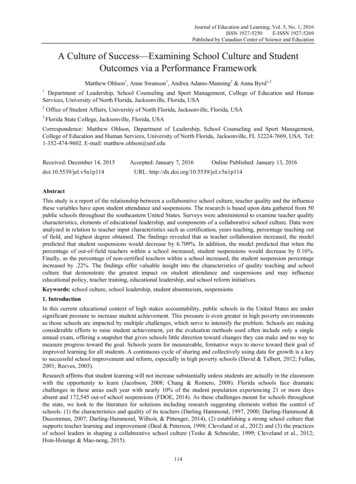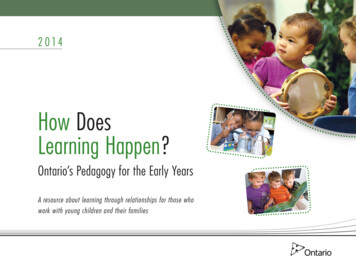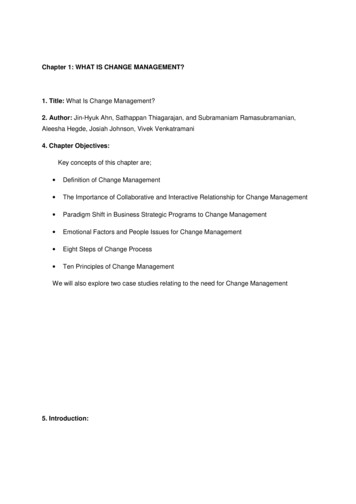
Transcription
Culture change:Making it Happen andMaking it StickMark Buchan.Change Catalyst atThe AgileLeaderS29/09/2014www.theagileleader.co.uk
Start with the end in mind S Plan your exit strategyS Design for continual adaptationS What’s important in the future may not be important now29/09/2014www.theagileleader.co.uk
UnfreezingS At the outset we need to be honest and understand that a vision forchange is hazy at best. We just know that“Things need to change around here”S However people wont always accept that this is the factS Our reasons for changing may be misinterpretedS Identifying impediments to growth and changeS Early stages focus on engagement and thinking through the changes29/09/2014www.theagileleader.co.uk
Build MotivationSPeople don’t like change SReally? Some people do; some people don’t SHowever, people don’t like BEING changed i.e. change from the top downSCulture change includes EVERYBODY, all the way up to the board ofdirectorsSEach team identifies and implements improvements (AUTONOMY,MASTERY, PURPOSE)SBy teams we are meaning from the SMT all the way through the organisation29/09/2014www.theagileleader.co.uk
Various views on changeS Top downS Bottom UpS Middle OutS But what about inside out? (Self)29/09/2014www.theagileleader.co.uk
LeadershipS Sponsorship from the very topS Identifying what they need to change for the desired cultureS Coaching around success of the culture change programmeS Leadership style coaching; adapting leadership style to suitenvironment29/09/2014www.theagileleader.co.uk
About change S People rarely change things unless they are feeling some amountof pain or things are not working properlyS An independent viewpoint can often help people see where theirbehaviours might be promoting a “status quo”S Helping people to understand that “people will treat you how youallow them to treat you”S In order to change the behaviour of the other we might have tomake a (resolute) behaviour change ourselves29/09/2014www.theagileleader.co.uk
Cycles of change29/09/2014www.theagileleader.co.uk
Offer a humanisticapproach to changeSChange is the responsibility of the person who has to make the changeSYou cant change anybodySYou cant make anybody think, feel or do anythingSIn our workplace we believe that each individual has the capacity and abilityto learn and changeSChange is not uncomfortable for everyoneSIts not that people don’t like change, its more that they don’t like being changedSSee people as capable of change – change that they initiateSShared vision – how do you contribute to this vision?29/09/2014www.theagileleader.co.uk
Being humanistic S means being compassionate andS forgivingS Treating people with goodwillS Having more adult-adult conversationsS Seeks to understand more about the other k
PaceS Find the pace of the organisation and look to continuallyincrease rate of changeS The goal is to find the optimal sustainable pace29/09/2014www.theagileleader.co.uk
Making MeaningS People will make meaning from whatever they observe, thatincludes what people say and what they doS We therefore must be careful as to how our behaviours are beinginterpretedS As part of the “Pacing Process” we ask people to make meaningof why we are changing our culture; meaning around theproposed cultureSThis “explorative” time helps surface what might be perceived asresistance to change29/09/2014www.theagileleader.co.uk
Engagement brought about byconversationS but more specifically dialogueS Where we balance advocacy and inquiryS Rather than talk at people (or planning your response)engage in inquiry – learn about the other29/09/2014www.theagileleader.co.uk
CommunicationSHow change is communicated is vital to the success of the initiativeSWhile talking is good to get the message out there, leaders need to improve theirlistening in order to understand how their message has been translatedSUnderstanding how our habitual thinking processes distort the communications we sendand receiveSSNLP: the meaning of your communication is in the response you getClean LanguageSThe ability to adapt our communication to suit the context and needSWe spend much time exploring communication styles in our “learning groups”29/09/2014www.theagileleader.co.uk
Spotting PatternsSWhen we spot patterns we are spotting patterns of behaviorSThese patterns of behaviour are often more visible to someone who is notsubjected to organisational biases (external consultants)SBy identifying impacts of our behaviour we can can start to plan differentbehaviour and its desired impactsSBehaviour is measurable and as such is one of the cornerstones in identifyingwhen we are “doing” as if we were in the desired cultureSOnce the current doing (conscious incompetence) becomes natural (consciouscompetence and finally unconscious competence) we then have our newhabits in place and are now part of our “being”29/09/2014www.theagileleader.co.uk
The Many Dimensions ofCulture29/09/2014www.theagileleader.co.uk
Making it stickS Put in place the behaviours and repeat them on a regular basis: Createa habitS Give people the opportunity to know that they are already on thepathS Provide natural points for reflection across the business thatinfluences future the behaviour of the members (Retrospective)(timebox planning)S Help people to talk to each other especially when giving feedbackS Make change the norm: Continual Improvement29/09/2014www.theagileleader.co.uk
Would you like tochat some more?S You can contact me on mark.buchan@theagileleader.co.ukS Personal Mobile: 07761234845S er.co.uk
make a (resolute) behaviour change ourselves 29/09/2014 www.theagileleader.co.uk. Cycles of change 29/09/2014 www.theagileleader.co.uk. Offer a humanistic approach to change S Change is the responsibility of the person who has to make the change S You cant change anybody S You cant make anybody think, feel or do anything S In our workplace we believe that each individual has the capacity











